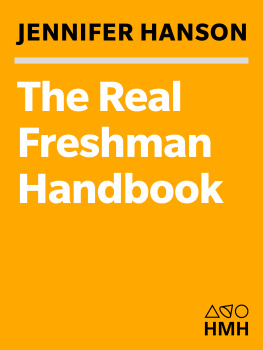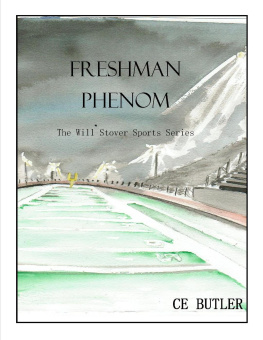
The Freshman
Before the advent of the teenager in the 1940s and the teenpic in the 1950s, The Freshman (Taylor and Newmeyer, 1925) represented 1920s college youth culture as an exclusive world of leisure to a mass audience. Starring popular slapstick comedian Harold Lloyd, The Freshman was a hit with audiences for its parody of contemporary conceptions of university life as an orgy of proms and football games, becoming the highest grossing comedy feature of the silent era. This book examines The Freshman from a number of perspectives, with a focus on the social, economic, and political context that led to the rise of campus culture as a distinct subculture and popular mass culture in 1920s America; Lloyds use of slapstick to represent an embodied, youthful middle-class masculinity; and the films self-reflexive exploration of the conflict between individuality and conformity as an early entry in the youth film genre.
Christina G. Petersen is Christian Nielsen associate professor of film studies at Eckerd College. She has published on identity and embodiment in American cinema, including essays on the origins of the youth film, the independent African American race film industry, international avant-garde cinema, and contemporary film exhibition technology.
Cinema and Youth Cultures
Cinema and Youth Cultures engages with well-known youth films from American cinema as well the cinemas of other countries. Using a variety of methodological and critical approaches, the series volumes provide informed accounts of how young people have been represented in film, while also exploring the ways in which young people engage with films made for and about them. In doing this, the Cinema and Youth Cultures series contributes to important and long-standing debates about youth cultures, how these are mobilized and articulated in influential film texts, and the impact that these texts have had on popular culture at large.
Series Editors: Sin Lincoln & Yannis Tzioumakis
The Virgin Suicides
Justin Wyatt
The Breakfast Club
Elissa H. Nelson
The Freshman
Christina G. Petersen
For more information about this series, please visit: https://www.routledge.com/Cinema-and-Youth-Cultures/book-series/CYC
The Freshman
Comedy and Masculinity in 1920s Film and Youth Culture
Christina G. Petersen
First published 2019
by Routledge
52 Vanderbilt Avenue, New York, NY 10017
and by Routledge
2 Park Square, Milton Park, Abingdon, Oxon, OX14 4RN
Routledge is an imprint of the Taylor & Francis Group, an informa business
2019 Taylor & Francis
The right of Christina G. Petersen to be identified as author of this work has been asserted by her in accordance with sections 77 and 78 of the Copyright, Designs and Patents Act 1988.
All rights reserved. No part of this book may be reprinted or reproduced or utilised in any form or by any electronic, mechanical, or other means, now known or hereafter invented, including photocopying and recording, or in any information storage or retrieval system, without permission in writing from the publishers.
Trademark notice: Product or corporate names may be trademarks or registered trademarks, and are used only for identification and explanation without intent to infringe.
Library of Congress Cataloging-in-Publication Data
A catalog record for this title has been requested
ISBN: 978-1-138-04639-9 (hbk)
ISBN: 978-1-315-17142-5 (ebk)
Typeset in Times New Roman
by codeMantra
For my family
Contents
Despite the high visibility of youth films in the global media marketplace, especially since the 1980s when Conglomerate Hollywood realized that such films were not only strong box office performers but also the starting point for ancillary sales in other media markets as well as for franchise building, academic studies that focused specifically on such films were slow to materialize. Arguably, the most important factor behind academias reluctance to engage with youth films was a (then) widespread perception within the Film and Media Studies communities that such films held little cultural value and significance, and therefore were not worthy of serious scholarly research and examination. Just like the young subjects they represented, whose interests and cultural practices have been routinely deemed transitional and transitory, so were the films that represented them perceived as fleeting and easily digestible, destined to be forgotten quickly, as soon as the next youth film arrived in cinema screens a week later.
Under these circumstances, and despite a small number of pioneering studies in the 1980s and early 1990s, the field of youth film studies did not really start blossoming and attracting significant scholarly attention until the 2000s and in combination with similar developments in cognate areas such as girl studies. However, because of the paucity of material in the previous decades, the majority of these new studies in the 2000s focused primarily on charting the field and therefore steered clear of long, in-depth examinations of youth films or were exemplified by edited collections that chose particular films to highlight certain issues to the detriment of others. In other words, despite providing often wonderfully rich accounts of youth cultures as these have been captured by key films, these studies could not have possibly dedicate sufficient space to engage with more than just a few key aspects of youth films.
In more recent (post-2010) years, a number of academic studies started delimiting their focus and therefore providing more space for in-depth examinations of key types of youth films, such as slasher films and biker films or examining youth films in particular historical periods. From that point on, it was a matter of time for the first publications that focused exclusively on key youth films from a number of perspectives to appear (Mamma Mia! The Movie, Twilight and Dirty Dancing are among the first films to receive this treatment). Conceived primarily as edited collections, these studies provided a multifaceted analysis of these films, focusing on such issues as the politics of representing youth, the stylistic and narrative choices that characterize these films and the extent to which they are representative of a youth cinema, the ways these films address their audiences, the ways youth audiences engage with these films, the films industrial location, and other relevant issues.
It is within this increasingly maturing and expanding academic environment that the Cinema and Youth Cultures volumes arrive, aiming to consolidate existing knowledge, provide new perspectives, apply innovative methodological approaches, offer sustained and in-depth analyses of key films, and therefore become the go to resource for students and scholars interested in theoretically informed, authoritative accounts of youth cultures in film. As editors, we have tried to be as inclusive as possible in our selection of key examples of youth films by commissioning volumes on films that span the history of cinema, including the silent film era; that portray contemporary youth cultures as well as ones associated with particular historical periods; that represent examples of mainstream and independent cinema; that originate in American cinema and the cinemas of other nations; that attracted significant critical attention and commercial success during their initial release; and that were rediscovered after an unpromising initial critical reception. Together, these volumes are going to advance youth film studies while also being able to offer extremely detailed examinations of films that are now considered significant contributions to cinema and our cultural life more broadly.








